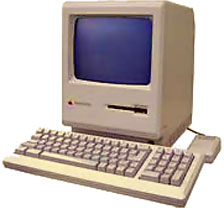Of all of the Triassic Macs, the Mac Plus has the most sentimental value among the Low End Mac community. For many 1980s computer users, it was the first Mac they ever owned. For others, it was the first device they used as a replacement for the venerable typewriter.
 The Mac Plus is probably the most durable Mac ever produced. Unlike the typewriter, there are no moving parts that need periodic cleaning and oiling. Indeed, other than the keyboard, the mouse, and the floppy drive, the Plus has no moving parts. It operates as a silent servant. The Plus is capable of silent operation because it doesn’t use any type of cooling fan. Cooling is done using passive convection through vents molded into the case.
The Mac Plus is probably the most durable Mac ever produced. Unlike the typewriter, there are no moving parts that need periodic cleaning and oiling. Indeed, other than the keyboard, the mouse, and the floppy drive, the Plus has no moving parts. It operates as a silent servant. The Plus is capable of silent operation because it doesn’t use any type of cooling fan. Cooling is done using passive convection through vents molded into the case.
Parts that don’t move tend to last a very long time – but there are a few exceptions. One non-moving part that has to be attended to from time to time is the Plus’ parameter settings (PRAM) battery. This battery allows the Plus to maintain its internal clock when the computer is not in use and is unpowered.
The Plus uses an Eveready 523 4.5 volt alkaline battery. The battery is about the size of the more familiar 1.5 volt AA cell that is used in portable CD players. The Eveready 523 battery is not the typical battery one can buy at a local discount store. It also does not have the long lifespan that is enjoyed by more modern lithium cells
As time and Mac models came and went, the old 523 became difficult to find. Batteries Plus, the specialty battery outfit, does not carry the 523 or its Ray-O-Vac equivalent. When my 523 died, Batteries Plus took 3 “1/2 AA” size 1.5 volt batteries and encased them in series using shrinkwrap thermoplastic. Presto! I had a new 4.5 volt PRAM battery for my Mac Plus. [Editor’s note: This battery is also known as a PX21 or A133, among other names. The Exell A21PX and Panasonic PX-21 are currently available replacements.]
Another problem that appears on the Triassic Mac Plus is the gradual decay of the video picture. This is due to the video board. This board, with its large electrolytic capacitors and transformer, is mounted sideways against one wall of the Plus. Over time the weight of the transformer pulls its contacts away from the circuit board. The result – an erratic picture.
A permanent fix requires resoldering the transformer back onto the circuit board. A provisional fix that also rectifies the problem calls for slapping the right side of the Plus so that the transformer is knocked back into its proper physical location. What interesting tales one learns from an old Apple techie! (I have tested the theory, and it appears to be sound.)
In terms of the electrolytic capacitors, after a decade or so the substances that make up the inside of the capacitor degrade. This can cause the capacitor to burn out. Once this happens, you have to replace the capacitors with new ones. See Replacements for High Failure Probability Parts on Mac 128K/512K/Plus Analog Board for a helpful parts list.
When Apple conceived the design for the Mac Plus in 1986, they anticipated that the computer buyer would keep the machine in use for a long time. Knowing this, they designed and built a machine that had few moving parts and would have a lifespan that would outlive several generations of Energizer Bunnies. How long a Mac Plus can last is still up to debate.
The last Plus came off the assembly line in 1990. Many thousands are still serving their masters in the new millennium. It would not be surprising to see Mac Pluses at work for many more years to come.
Keywords: #macplus #trassicmac
Short link: http://goo.gl/AOMSKP
searchword: macpluscare

